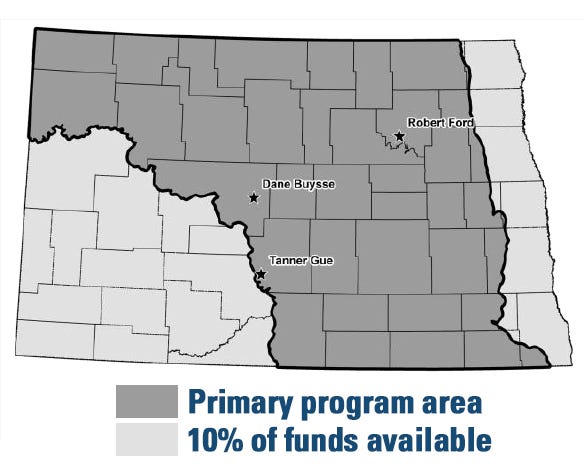February 12, 2019

Ducks Unlimited’s Cover Crop and Livestock Integration Project (CCLIP) is expanding in North Dakota. The program offers 60% cost share of expenses to add grazing infrastructure to cropland and to purchase cover crop seed.
CCLIP was a pilot program in a few southeast North Dakota counties last year. This year, it will be available to landowners in the 37 counties that encompass the Prairie Pothole Region in the state.
Money for the program comes from the North Dakota Outdoor Heritage Fund. In summer 2017, the fund awarded Ducks Unlimited $620,000 that funded CCLIP’s startup. With those funds, DU completed 14 projects on 3,500 acres of grassland, 3,500 acres of cropland and 500 acres of wetlands. Twelve additional projects are pending from this initial effort.
The Outdoor Heritage fund recently awarded DU and its partners a $1.25 million grant.
“One of our goals with this program is to reduce some of the economic pressures producers feel to drain small, yet significant wetlands that are imbedded in croplands,” says Tanner Gue, Ducks Unlimited regional biologist.
This assistance gives farmers and ranchers the tools to prove to themselves these practices work for their operational goals, he says.
 ELIGIBLE COUNTIES: Land is the prairie Pothole Region of North Dakota (shown in grey) are eligible for a Ducks Unlimited new working-lands conservation program.
ELIGIBLE COUNTIES: Land is the prairie Pothole Region of North Dakota (shown in grey) are eligible for a Ducks Unlimited new working-lands conservation program.

According to Gue, the regenerative agricultural practices promoted by CCLIP restore organic matter to the soil, reduce soil compaction and increase water infiltration. Maintaining livestock on the landscape allows recovery time on perennial pastures and the CCLIP five-year contract protects small wetlands important for breeding waterfowl.
All these practices result in more productive cropland, healthier soil, increased flood protection and improved waterfowl habitat, Gue says.
Landowners enrolled in CCLIP enter a five-year agreement. Provisions on enrolled grassland acres include: no wetland manipulation, no grassland conversion, must have a rotational grazing plan. Provisions on enrolled cropland acres include: no wetland manipulation, must plant cover crops as many years as rotation allows, and must graze livestock on cropland aftermath and/or cover crops if there is enough forage to do so.
CCLIP Project partners include North Dakota Natural Resources Trust, Pheasants Forever, North Dakota Game and Fish, local North Dakota Soil Conservation Districts, North Dakota Grazing Lands Coalition, Millborn Seeds and Pulse USA.
Established in 1937, Ducks Unlimited has conserved more than 14 million acres.
Source: Ducks Unlimited, which is solely responsible for the information provided and is wholly owned by the source. Informa Business Media and all its subsidiaries are not responsible for any of the content contained in this information asset.
You May Also Like




